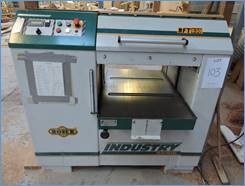All lots exceed reserve in online auction of Dubois Naval Architects
Marriott & Co. secured an excellent result in the recent online auction of the assets of leading design firm Dubois Naval Architects Ltd (In Liquidation).
Why Insurance Valuations Matter to Your Business
How much would it cost to reinstate your business in the event of a loss?
It is both surprising and alarming how many business owners cannot answer this question with confidence.
Have you considered the indemnity period you will require, the effect Brexit and the fall of the pound will have on importing your replacement plant and machinery, the changes in your stock level since you last renewed your business insurance policy, the last time you had your business professionally valued etc. etc.?
The Aviva SME Pulse survey 2015 found that 1 in 5 SMEs were not confident they had the correct insurance cover. Given the risk of underinsurance, this is a pretty shocking statistic. Should anything have happened to the businesses in question, they would have been left to bridge the gap between the insurance cover and the actual replacement costs.
To put this into context, Marriott & Co. recently found a major printing facility to be underinsured by 80%. Had a major loss occurred they would have been faced with finding 80% of the replacement costs from their own resources, at a cost of several million pounds.
If that isn’t a shocking enough statistic for you, a recent Aviva survey of 383 commercial property clients found that 177 (that’s 46%) had underinsured their business by an average of £486,000, a reserve that many businesses just do not have.
It is no surprise that the Financial Conduct Authority is concerned over the ‘alarming degree of under-insurance.’
On the other side of the coin, what if you are paying over the odds for your business insurance cover? Can you really afford to be paying more than you need?
Getting it right is important, and that is where the role of professional valuers comes into play.
BIBA (the British Insurance Broker’s Association) advise businesses to use professional valuation services regularly to make sure that sums insured are correctly assessed. The risk of not paying the correct insurance cover will be higher if you have not received a professional valuation within the last three years.
Independent and RICS Registered Chartered Valuation Surveyors, such as Marriott & Co., provide expert, and, more importantly, impartial insurance valuations of your business assets. They will be aware of the influencing factors on replacement costs (such as exchange rates and inflation) that may otherwise go overlooked. By employing their services, you can be sure that your insurance cover is accurate and protect your business from the risk of financial liability.
Hopefully disaster never strikes, but if it does, isn’t it better to be prepared?
By Frances Smithson
Is Valuation an Art or a Science?
This is an age old question pondered by valuation experts many times over. I believe that most valuers tend to err on the side of valuation being an art rather than a science, mainly on the basis that it requires judgment and is a statement of opinion not fact.
However, I believe it is reasonable to disagree with the proposition that valuation is an art not a science to some extent, i.e. one could argue that it is probably a mixture of the two.
The fact that one follows a logical process in reaching a valuation opinion means that there are, it can be argued, scientific elements to it. For example, a rental valuation of an industrial building involves carrying out relevant research such as finding out rental comparables and yields acceptable for similar buildings. This objective evidence is then used to formulate and support the valuer’s opinion.
The art lies in the subjective judgement(s) that a valuer makes, having considered the research/evidence carried out, in actually putting a figure against an asset and in making appropriate adjustments, e.g. for differences between assets. However, the interim process of gathering evidence and making calculations, it can be said is more scientific than artful, in that it is methodical and planned, rather than spontaneous and creative.
Certain types of valuation are more scientific than others, e.g. insurance valuations are more a case of calculating costs and making calculations, and there is less valuation ‘judgement’ involved than with, for example, market valuations.
If valuation were ‘pure art’ then one could argue that it would simply be a case of valuers applying figures to assets perhaps without following any kind of definable thought process. This, one can argue, would not be a proper valuation, as a valuer must be able to explain their opinion with reference to evidence (e.g. showing comparable sales evidence). The whole proposition centres on the question of what defines art and science.
From a ‘purist’ perspective, some would argue that valuation is neither science nor art; it is its own subject entirely. However, from a general perspective, it may be argued that there are scientific elements to all art (e.g. music can be quantified and measured and transposed into written form), and therefore science and art can, and often are, interrelated. One could surmise that science and art are both ‘human’ concepts; one being the concept of reason and the other being the concept of creativity. If valuation has to be placed into one of those two brackets (reason or creativity), then most laymen might opt for reason because it is a subject which follows logical procedures (for example DCF techniques) and employs specific calculations (such as the DRC method) and, importantly, if a valuer is forced to defend his opinion in court, most would be happier doing so having used reason as their prime approach.
Join Us
To keep up to date with the activities and online auction sales happening at Marriott & Co. please join us on Facebook www.facebook.com/marriottauctions
SESCA
The SESCA annual residential insolvency conference is just around the corner, on Thursday 30 June and Friday 1 July at the Surrey University, Guildford, have you booked your place?
There are a range of speakers throughout the seminar covering topical subjects. Marriott & Co. will be attending and also hosting pre-dinner drinks in the bar on Thursday 30 June.
We hope you will be joining the event, further details can be viewed at www.sesca.co.uk/sesca_insolvency_conference_2016.html
Marriott & Co. Spring 2016 Newsletter
A busy start to the year for the Marriott & Co. disposal team with various online asset sales completed. The assets sold included Sheet Metal Machine Tools, Woodworking Equipment, Motor Vehicles, Audio Visual Stage Equipment, Motorbikes and Scooters, stock of Formal Menswear, a vast Model Train Collection together with a sale of a Residential House in the Dordogne. Ongoing negotiations for the sale of a solvent Property Maintenance Company continue.
Our valuation team have also been busy with some interesting valuations.
Marine Catering Equipment Manufacturer – for over 60 years from their factory in Southampton, the company manufactured Galley Catering Equipment for the Marine Industry. We offered for sale its engineering production assets by online auction, as well as its unfinished work in progress and its intangible assets including its goodwill and trading name. Our targeted marketing generated considerable interest in the assets and the resulting realisation exceeded all expectations. Following the sale and our overseeing the safe removal of the machinery we left the premises clear and tidy.
Timber Framed Buildings Manufacturer – From its vast premises in Andover this company manufactured timber framed buildings. After providing the valuation required for the liquidators our instructions were to dispose of the assets. An online auction was arranged for the joinery machinery and equipment and the strong interest obtained from our marketing ensured the assets achieved their maximum realisation.
Residential Property in the Dordogne – Our assistance provided to a retained client in finding a buyer for his French residence, proved successful late last year. Our marketing found an American couple to complete a purchase of the property. The sale compromis was signed in December and the final Acte de Vente is set for early March.
 Stage Production Company – The curtain finally went down on a company which held theatrical licences for Fireman Sam and Tree Fu Tom, the popular children’s television programmes, when the company was placed into Liquidation late last year. We sold the stage production equipment and motor vehicles and ensured licenced costumes and stage props were returned to the licence holders.
Stage Production Company – The curtain finally went down on a company which held theatrical licences for Fireman Sam and Tree Fu Tom, the popular children’s television programmes, when the company was placed into Liquidation late last year. We sold the stage production equipment and motor vehicles and ensured licenced costumes and stage props were returned to the licence holders.
 Hornby and Bachmann model locomotives collection – On behalf of the Trustee in Bankruptcy we removed the vast collection from the matrimonial home. Apart from the valuable engines the collection included 1000’s of photograph albums. The albums recorded and referenced trains at various locations throughout the UK back to the early 1970’s. This comprehensive reference library has become a liability rather than an asset. Even the Bankrupt, the creator of the library, chose not to keep it! At the weigh-in at the local recycling centre the albums registered over a tonne in weight!
Hornby and Bachmann model locomotives collection – On behalf of the Trustee in Bankruptcy we removed the vast collection from the matrimonial home. Apart from the valuable engines the collection included 1000’s of photograph albums. The albums recorded and referenced trains at various locations throughout the UK back to the early 1970’s. This comprehensive reference library has become a liability rather than an asset. Even the Bankrupt, the creator of the library, chose not to keep it! At the weigh-in at the local recycling centre the albums registered over a tonne in weight!
Menswear Company in Liquidation – In order to exit the company’s premises swiftly following a closing down sale in December we had to achieve sales of the remaining stock and fixtures & fittings from this company’s retail store and also its formal menswear hire shop in very short order. The stock was not valuable enough to warrant transport costs in uplifting and additional storage charges, so a short notice sale was arranged and completed prior to incurring any additional rent costs. The realisations exceeded our expectations thanks to some professional and targeted marketing by the disposals department.

Goodwill Valuations – Interesting valuations completed in recent months included a retrospective statutory market valuation of an engineering firm’s assets (which were transferred from a partnership to a limited company in 2011) in accordance with the Taxation of Chargeable Gains Act 1992 definitions. The main asset under scrutiny was the company’s goodwill and so investigations needed to made in conjunction with the company’s accountant.
Another interesting recent valuation was carried out for a recruitment company specialising in the childcare sector. Again the main asset was goodwill (and intangibles) only this time the basis of valuation adopted was IVS Fair Value as defined in IVS Framework paragraphs 38 to 42 as ‘the estimated price for the transfer of an asset or liability between identified knowledgeable and willing parties that reflects the respective interests of those parties’. This basis was adopted because the assets were to be transferred in-situ to a related party, effectively as a going concern. It differs from Market Value and was appropriate in this case.
For both the above valuations, it was up to Marriott & Co. to advise our client as to correct basis of valuation at the outset. It is often the case that clients are not familiar with the correct basis and assumptions to make in order to comply with the RICS standards and any statutory requirements. That is one of the reasons why it is so essential that valuations are carried out by qualified valuers like Marriott & Co.
Should you have any requirements for asset valuation or asset disposals, then please do not hesitate to contact any of the team here.
Tom Allman’s Dissertation
In 2013 our Director of Valuations, Tom Allman, completed his BSc degree in Estate Management achieving First Class Honours.
His final year dissertation was a project entitled: “a researched refinement of the Depreciated Replacement Cost (DRC) method as a guide to market values (MV) for Machinery & Business Assets valuers.”
Depreciated Replacement Cost (DRC) is a valuation method that can be used by machinery valuers as a tool for estimating market value in the absence of reliable comparable evidence. Many would question its reliability and whether it produces MV. Its use involves estimating the economic life and residual value of a machine, in order to derive its DRC. This is calculated by using the machine’s current new replacement cost and a reducing-balance depreciation profile table to ascertain an estimated value at a certain point in the machine’s life. This produces a theoretical value (DRC) which can then be adjusted for any assumptions (such as removal costs etc.) to estimate its market value. The perceived problem that Tom addressed in his dissertation was that the prediction of economic life and residual value are largely subjective and usually based on a valuer’s skill and experience. Such subjective judgments might prove difficult to defend in court.
The dissertation investigated the idea that DRC could be made more useful for machinery valuers, by objectifying estimates of residual value and economic life (i.e. basing them on empirical market evidence). Part of the research analysed market evidence of reducing-balance depreciation rates for three different categories of machinery in order to derive and conclude average depreciation rates per year for each category, to use as a starting point, which can then be adjusted to reflect the attributes of the particular machine being valued. The following average reducing balance depreciation rates were concluded (although different manufacturers indicated different rates):
Construction Plant – 13.5% per year
Lithographic Printing Machines – 11% per year
CNC Machine Tools – 14% per year
One of the main findings of the project is that the categories investigated generally tend to depreciate at a slightly higher rate per year at the beginning of their lives than at the end. This means that using a different reducing-balance rate depending on the age of the machine being valued, may be justified and appropriate, when using DRC to estimate MV.
The project involved analysing real auction results and Tom’s findings included the fact that the Marriott & Co. auction results analysed, on average, indicated lower depreciation rates than other sales evidence for both printing machines and CNC machine tools. This appeared to indicate that Marriott & Co. was outperforming its contemporaries by achieving better auction results. Although discovering this was not one of the objectives of the research, it was something we were obviously pleased to learn and were keen to share with our clients!
The legal sources of law in England and Wales
I thought I would post this essay as a ‘refresher’ for busy professionals who sometimes need reminding of the basic principles underlying the established legal system we all abide by.
There are two main legal sources that court judgments are based on. These two sources are legislation, formed under the authority of Parliament, and case law, known as judicial precedent. Judges have to take account of both of these sources in reaching a decision and so both sources need to be understood by business professionals.
Legislation in England and Wales is created by the sovereign body of Parliament. This sovereign body consists of the Queen, whose role is purely formal, the House of Commons, which is the main body that creates legislation in the form of statutes and the House of Lords, which is the Supreme Court. A statute is an act of Parliament and is binding i.e. it cannot be challenged in any English court.
Primary legislation is formed through Parliament alone and cannot be challenged in UK courts. The finer details of primary legislation are often decided by an appropriate, appointed public body such as the Health and Safety Executive or a local authority. This is known as delegated legislation, as it does not come directly from Parliament, and these statutory rules can be challenged in court.
The Judiciary are bound by Parliament’s power to create statutes and must make decisions based on the existing legislation. However, the English system of law allows a considerable amount of discretion in decision making. It is down to the individual judge to interpret Acts of Parliament and apply them to cases. To do this they must use intrinsic and extrinsic aids. Intrinsic aids are contained within the act itself, e.g. specific words or phrases that emphasise the intention of a policy. Extrinsic aids could be information concerning legislative background, the prevailing political climate or general presumptions in the system (such as the presumption against violating international law).
When a court interprets legislation or supporting documents they are able to use different ‘rules of construction’ to try and ascertain Parliament’s intention. This has the effect that different results could occur in different courts if the same case were tried. The two main rules of construction are the literal rule (meaning the words are interpreted according to their exact meaning as in the case of Kahn V Newbury 1959) and the golden rule (which allows more assumptions based on ‘common sense’). Usually one rule or the other is suitable depending on whether or not ambiguity exists in the wording.
The other main legal source of law is known as the doctrine of judicial precedent and is based on the latin principle of stare decisis meaning ‘to stand upon decisions’. What this means is that judges have to follow previous decisions made by superior courts as they are binding. The ratio decidendi, i.e. the reason for the decision, is the part of a previous judgment that is binding and, as such, this reasoning must be applied to cases afterwards.
The other words used in the application of previous judgments (known as obiter dicta) may also be used, as material considerations, but are not legally binding. The doctrine of binding precedent is dependent on accurate and exhaustive law reporting.
The House of Lords (the Supreme Court) is the only court not bound by its or any other courts previous decisions. The Court of Appeal is bound by all decisions of the House of Lords and also its own previous decisions (although its criminal division allows for more discretion as justice overrides consistency as a principle, more so than in the civil division). The High Court is bound by the decisions made in the House of Lords and the Court of Appeal (and also its own previous decisions in the case of divisional courts). All other courts do not bind either themselves or others.
In summary then, judges are bound by law to abide by Acts of Parliament, by interpreting them, and are also bound by the reasons for previous decisions of superior courts. Any other considerations in making a judgement are ‘material’.
The English system is primarily considered to be a discretional one (there is no written constitution as in many other countries), however, the power of Parliament to legislate and the binding and unchallengeable (except in EU courts) nature of statutes means that the government controls the political landscape and legislative ethos of the time. Crucially though, Parliament cannot bind itself and so, to some extent, power lies with the voters.
References
College of Estate Management. Paper 6024: Sources of English Law. Reading: CEM
Keenan D (2007) Smith and Keenan’s English Law Text and Cases (15th edition). Harlow: Pearson
The UK Statute Law Database (2009) [Website] Available from: <www.statutelaw.gov.uk/content> [Accessed 10 March 2009]
Office of Public Sector Information (2009). OPSI [Website ]. Available from: <www.opsi.gov.uk/RevisedStatutes/Acts/ukpga_19820029_en> [Accessed: 6 March 2009]
Department for Business Enterprise & Regulatory Reform (2009). BERR [Website]. Available from: <www.berr.gov.uk/whatwedo/consumers/fact-sheets/page38337.html> [Accessed 6 March 2009]
Written by Thomas Allman
Printing shop insolvency
This company was an insolvency which we dealt with a few years ago and it had many different aspects to it.
The case involved us attending a printing shop and carrying out a survey of all the chattel assets on site (which included printing machinery and equipment as well as office furniture /equipment) then producing a market valuation report and categorising the assets as either unencumbered, financed or third party owned. We were then asked to dispose of the company’s chattel assets and arrange the clearance of its two buildings, which we managed by way of an online sale by closed tender using our auction software package. We also had to make contact with finance companies to try and arrange the disposal of their assets.
We sold assets on behalf of the Liquidator and also the former Director. This was because some of the most valuable assets belonged to either the company’s Pension Fund or the Director’s sister company. We had already been made aware by the Director that he would be looking to sell these machines (including two Heidelberg presses) and once we were given the instruction to dispose of the unencumbered assets by the Liquidator, we suggested to the Liquidator that we should ask if we could sell the Pension fund / sister company machines as well in order to make the overall sale more attractive. The decision to have an online tender rather than auction was taken as we thought that the lack of widely desirable / major assets may mean that ‘special purchasers’ would bid much more than the under bidder for certain lots. This decision was justified by the excellent sales results. For many of the lots there was no ‘underbid’, or only a much lower ‘underbid’, and therefore an auction would likely have been less successful.
The strategy of including all the assets and having a tender was very successful and we ended up achieving several prices above our valuation due to the increased interest and resultant (perceived) competition. Another good decision was to include a Morgana folding machine in the sale which had a sum outstanding on finance which was higher than we valued the machine for but we actually ended up selling it for a price above valuation which enabled us to settle the finance outstanding left some equity for the Liquidation.
We received a letter of congratulations and thanks from the former Director as result of our effort and the Liquidator was also very pleased and paid our time costs in full. We have since received further instructions from this client, despite the fact that they are based in Sheffield. Marriott & Co. had been recommended to them by a northern contemporary of ours due to our specialization in the printing industry.
Insurance Valuations
By Thomas Allman MRICS
Back in the day (or so I’m told!) insurance valuations were ‘all the rage’. 40 years ago or so, insurance valuations made up a large proportion of an asset valuer’s work load. One reason for this could be the high inflation back in the 1970s meaning that under insurance was an even greater risk than it is today. Most insurance policies offer a ‘new for old’ replacement basis in the event of loss, and back then new replacement costs went up by significant sums year upon year, and unless they were regularly reviewed, insured values would often lag behind at inadequate levels.
It seems to be that as UK inflation has settled down (stabilising to a target of 2% a year since Tony Blair came into power 18 years ago and currently sitting at barely anything), so the perceived requirements for insurance valuations seem to have waned. And yet, with exchange rates still being the major factor affecting changes in new replacement costs, it seems strange to me that more Directors are not concerned about under insurance. Surely more of them should realise that it is the duty of Directors to ensure that a business’s assets are insured at the correct replacement cost. With the strengthening of the pound against the Euro in recent years, whilst weakening against the Swiss Franc, new replacement costs in GB£ for internationally manufactured machines (which most machines are, sadly) are not easily estimated. Companies with significant fixed assets whose Directors neglect to revalue their assets each year are putting their shareholders’ interests at risk. An insurance valuation need not be a costly exercise and could potentially save shareholders millions of pounds in the event of a loss. Whilst (rightly) large budgets are allowed for physical loss -prevention measures (risk aversion in the more obvious sense), under insurance is only perceived to be a problem as and when a loss occurs.
The RICS regulated services that Marriott & Co. and our contemporaries can provide, are of benefit to manufacturing businesses. With Climate Change seemingly contributing to more extreme weather worldwide (UK flooding being a prime example), now is the time to remind directors of the potential devastation from which their companies might not recover unless their sums insured have been correctly declared.
Quite simply, many manufacturing companies are under-insured, thereby risking receiving only a proportion of the value lost in any claim. Companies that are professionally advised and adopt an up-to-date plant reinstatement assessment, are doing all they can to eliminate the risk.
n.b. the RICS guidance has changed over the years in that when I started carrying out valuation work in 2007, we were not supposed to use the term ‘insurance valuation’ (which was historically what such exercises had been known as) because technically it is not a valuation but rather a cost estimate, however, in recent years the term has come back into usage in RICS correspondence and so some people have reverted back to using the term (and I am sure many people never stopped using it in the first place!).







